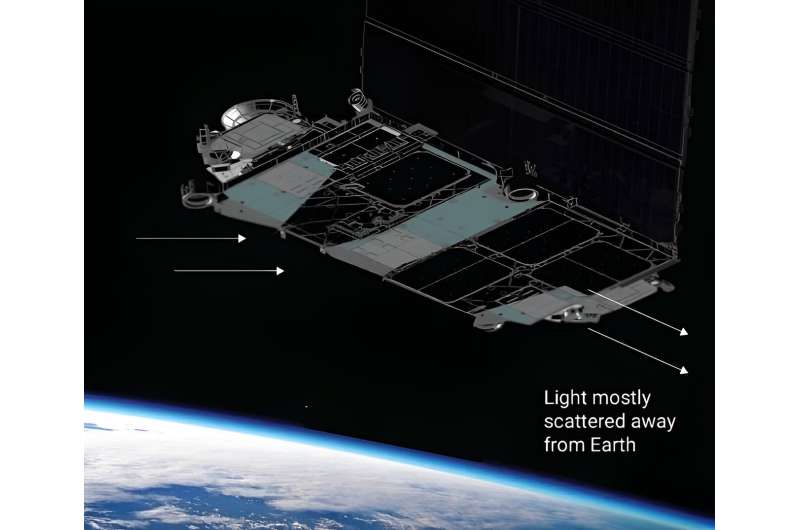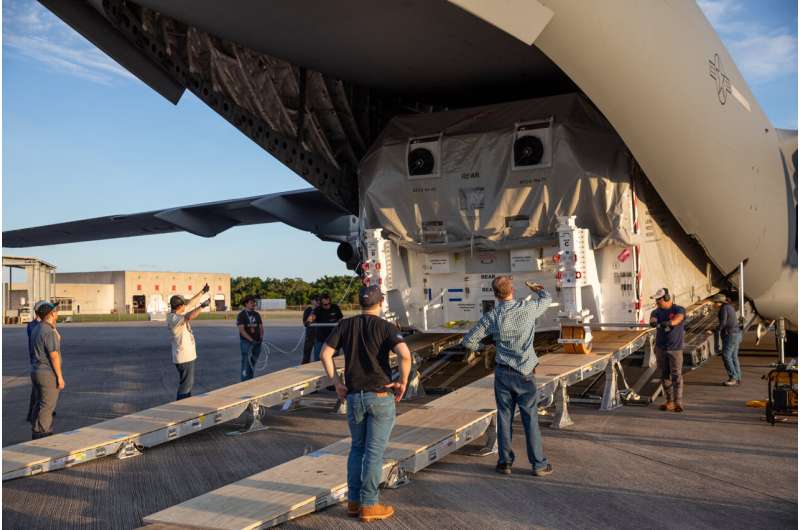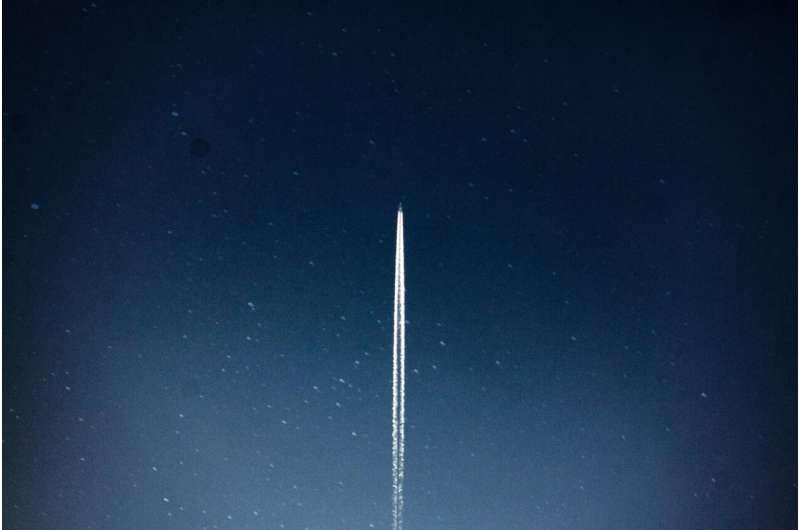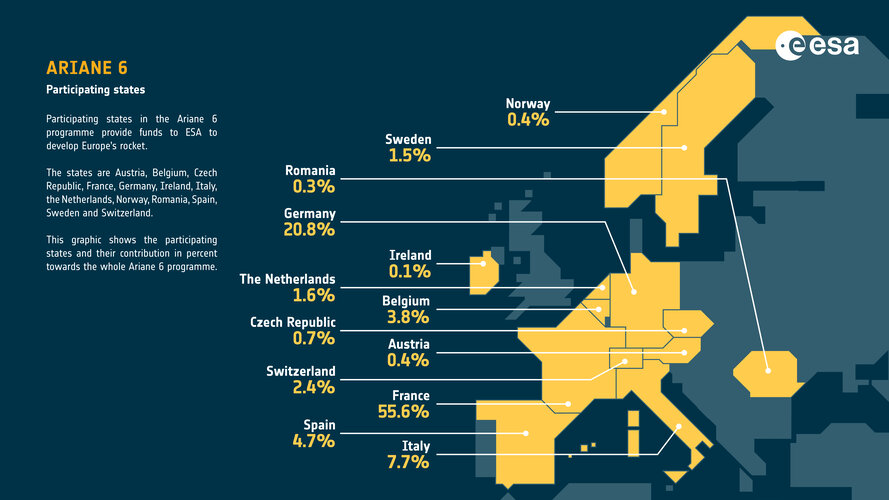Starlinks can produce surprisingly bright flares for pilots
Monday, 27 May 2024 16:46

How can sunlight reflecting off SpaceX's Starlink satellites interfere with ground-based operations? This is what a study recently posted to the arXiv preprint server hopes to address as a pair of researchers investigate how Starlink satellites appear brighter—which the researchers also refer to as flaring—to observers on Earth when the sun is at certain angles, along with discussing past incidents of how this brightness has influenced aerial operations on Earth.
This study holds the potential to help spacecraft manufacturers design and develop specific methods to prevent increased brightness levels, which would help alleviate confusion for observers on Earth regarding the source of the brightness and the objects in question.
Here, Universe Today discusses this research with Anthony Mallama of the IAU—Center for the Protection of Dark and Quiet Skies from Satellite Constellation Interference regarding the motivation behind the study, significant results, potential follow-up studies, importance of studying Starlink satellite brightness, and implications for managing satellite constellations in the future.
Fish are adapting to weightlessness on the Chinese space station
Monday, 27 May 2024 16:06
Four zebrafish are alive and well after nearly a month in space aboard China's Tiangong space station. As part of an experiment testing the development of vertebrates in microgravity, the fish live and swim within a small habitat aboard the station.
While the zebrafish have thus far survived, they are showing some signs of disorientation. The taikonauts aboard Tiangong—Ye Guangfu, Li Cong, and Li Guangsu—have reported instances of swimming upside down, backward, and in circular motions, suggesting that microgravity is having an effect on their spatial awareness.
The zebrafish were launched aboard Shenzhou-18, which carried them, as well as a batch of hornwort, to orbit on April 25, 2024. The aim of the project is to create a self-sustaining ecosystem, studying the effects of both microgravity and radiation on the development and growth of these species.
As a test subject, zebrafish have several advantages.
NASA's Europa Clipper makes cross-country flight to Florida
Monday, 27 May 2024 14:09
Assembled at NASA's Jet Propulsion Laboratory in Southern California, the spacecraft arrived at the agency's Kennedy Space Center in Florida on May 23 for launch preparations.
NASA's Europa Clipper, a spacecraft designed to investigate Jupiter's icy moon Europa and its potential to support life, arrived in Florida on Thursday, May 23. The spacecraft, assembled at NASA's Jet Propulsion Laboratory in Southern California, landed aboard a United States Air Force C-17 Globemaster III aircraft at the Launch and Landing Facility at NASA's Kennedy Space Center.
Saudi fund launches new group to boost space industry
Monday, 27 May 2024 12:33
Saudi Arabia's Public Investment Fund (PIF)on Monday launched the Neo Space Group to work on the kingdom's nascent satellite and space industry, its first investment in the sector.
One of the world's largest sovereign wealth funds, the PIF has already invested heavily in sports, gaming and so-called Saudi giga-projects including Neom, a $500-billion futuristic megacity under construction in the desert.
The Neo Space Group or NSG is the "PIF's first investment focused on the space industry", the sovereign wealth fund said in a statement.
It "aims to develop and enhance commercial space operations in Saudi Arabia, providing innovative satellite and space solutions locally and globally", the PIF said.
It will also "invest in localization, technology, start-ups, and knowledge in the space and satellite sector in Saudi Arabia" in the latest bid to boost economic diversification.
Under Crown Prince Mohammed bin Salman, the de facto ruler, Saudi Arabia has sought both to open up and diversify its oil-reliant economy.
From world-class footballers to a new national airline and even a speciality shop serving camel milk gelato, the PIF has splashed billions on acquisitions intended to support diversification.
Ariane 6 infographic: participating states
Monday, 27 May 2024 08:49 Image:
Ariane 6 infographic: participating states
Image:
Ariane 6 infographic: participating states Meteor captured by weather satellite
Sunday, 26 May 2024 21:07 A meteor recently lit up the skies over Spain and Portugal, and was also captured by the Meteosat Third Generation Imager weather satellite hovering 36,000 km away in geostationary orbit.
"While a meteor lit up the skies over Spain and Portugal recently, it was also captured by the Meteosat Third Generation Imager weather satellite hovering 36,000 km away in geostationary orbit."
On
A meteor recently lit up the skies over Spain and Portugal, and was also captured by the Meteosat Third Generation Imager weather satellite hovering 36,000 km away in geostationary orbit.
"While a meteor lit up the skies over Spain and Portugal recently, it was also captured by the Meteosat Third Generation Imager weather satellite hovering 36,000 km away in geostationary orbit."
On Space Force plans to fill Satellite Procurement Gap with Space Test Experiments Platform
Sunday, 26 May 2024 21:07 The Space Test Program (STP) office has released the Request for Proposal (RFP) for the Space Test Experiments Platform (STEP) 2.0 contract. This move enables STP to secure complete solutions for the U.S. Space Force's Science and Technology (S and T) experiments.
"The DoD Space Test Program is looking to leverage all the successes from industry to provide proven spacecraft to host the DoD
The Space Test Program (STP) office has released the Request for Proposal (RFP) for the Space Test Experiments Platform (STEP) 2.0 contract. This move enables STP to secure complete solutions for the U.S. Space Force's Science and Technology (S and T) experiments.
"The DoD Space Test Program is looking to leverage all the successes from industry to provide proven spacecraft to host the DoD Earth Observation advances with Marble Imaging and Reflex Aerospace partnership
Sunday, 26 May 2024 21:07 Marble Imaging, supported by Reflex Aerospace, aims to transform the Earth Observation (EO) industry with a constellation of up to 200 small satellites. This initiative seeks to position Marble Imaging as Europe's leading EO company, offering very-high resolution (VHR) images of the entire planet daily. Reflex Aerospace, a German satellite manufacturer, provides satellite platforms known for the
Marble Imaging, supported by Reflex Aerospace, aims to transform the Earth Observation (EO) industry with a constellation of up to 200 small satellites. This initiative seeks to position Marble Imaging as Europe's leading EO company, offering very-high resolution (VHR) images of the entire planet daily. Reflex Aerospace, a German satellite manufacturer, provides satellite platforms known for the Unlocking the secrets of supercritical fluids
Sunday, 26 May 2024 21:07 A study now published in Nature Communications provides new insights into the behavior of supercritical fluids, a state of matter between liquids and gases, with applications ranging from the pharmaceutical industry to planetary science. The findings, achieved at the Institut Laue Langevin (ILL), were at the limits of current experimental possibilities.
A supercritical fluid is a substance
A study now published in Nature Communications provides new insights into the behavior of supercritical fluids, a state of matter between liquids and gases, with applications ranging from the pharmaceutical industry to planetary science. The findings, achieved at the Institut Laue Langevin (ILL), were at the limits of current experimental possibilities.
A supercritical fluid is a substance iSpace and LeicesterU to develop Lunar Night Survival technologies
Sunday, 26 May 2024 12:41 ispace, inc. (ispace), a global lunar exploration company, and the University of Leicester, have agreed to collaborate on approaches to lunar night survivability for future ispace lunar lander and rover missions.
The University and ispace have entered into a strategic consulting agreement to explore lunar night survivability utilizing Radioisotope Heater Units on the Series 3 lunar lander and r
ispace, inc. (ispace), a global lunar exploration company, and the University of Leicester, have agreed to collaborate on approaches to lunar night survivability for future ispace lunar lander and rover missions.
The University and ispace have entered into a strategic consulting agreement to explore lunar night survivability utilizing Radioisotope Heater Units on the Series 3 lunar lander and r NASA's TESS Finds Intriguing World Sized Between Earth, Venus
Sunday, 26 May 2024 12:41 Using observations by NASA's TESS (Transiting Exoplanet Survey Satellite) and many other facilities, two international teams of astronomers have discovered a planet between the sizes of Earth and Venus only 40 light-years away. Multiple factors make it a candidate well-suited for further study using NASA's James Webb Space Telescope.
TESS stares at a large swath of the sky for about a month at
Using observations by NASA's TESS (Transiting Exoplanet Survey Satellite) and many other facilities, two international teams of astronomers have discovered a planet between the sizes of Earth and Venus only 40 light-years away. Multiple factors make it a candidate well-suited for further study using NASA's James Webb Space Telescope.
TESS stares at a large swath of the sky for about a month at Astronomers Discover 15 New Exoplanets and Measure Mass of 126 Others
Sunday, 26 May 2024 12:41 Using data from the Transiting Exoplanet Survey Satellite (TESS) and W.M. Keck Observatory on Mauna Kea in Hawaii, an astronomer at the University of Kansas has led a study revealing 15 new exoplanets and determining the mass of 126 others. The findings provide new insights into the composition of exoplanets and their star systems.
The study, part of the TESS-Keck Survey, is published in T
Using data from the Transiting Exoplanet Survey Satellite (TESS) and W.M. Keck Observatory on Mauna Kea in Hawaii, an astronomer at the University of Kansas has led a study revealing 15 new exoplanets and determining the mass of 126 others. The findings provide new insights into the composition of exoplanets and their star systems.
The study, part of the TESS-Keck Survey, is published in T Scientists observe CO2 and CO ices in the outer solar system
Sunday, 26 May 2024 12:41 For the first time, carbon dioxide and carbon monoxide ices have been observed in the far reaches of our solar system on trans-Neptunian objects (TNOs).
A research team, led by planetary scientists Mario Nascimento De Pra and Noemi Pinilla-Alonso from the University of Central Florida's Florida Space Institute (FSI), made the findings by using the infrared spectral capabilities of the Jame
For the first time, carbon dioxide and carbon monoxide ices have been observed in the far reaches of our solar system on trans-Neptunian objects (TNOs).
A research team, led by planetary scientists Mario Nascimento De Pra and Noemi Pinilla-Alonso from the University of Central Florida's Florida Space Institute (FSI), made the findings by using the infrared spectral capabilities of the Jame 




